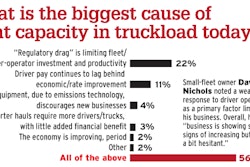I’m putting together a feature on some of the tools and tactics out there for owner-operators with their own authority to capitalize on the rate dynamic we’ve seen over the last year or so. The load-to-truck metric in any given geographical area, available from most load-board services provided you’re a member, is a fairly good indicator of where you stand in terms of negotiating power, if you’re using brokers. Few trucks in an area + an overabundance of available loads = $.
That’s oversimplifying it, but you get the drift.
Line-haul averages for your segment are a good rate marker as well. But as Kentucky-based owner-operator and sometime independent O-O dispatcher Chad Boblett this week reminded the listeners of Rico Muhammad’s “Rates and Lanes” podcast, part of Kevin Rutherford Let’s Truck/AudioRoad Blog Talk Radio network, if you’re not doing any direct freight but are relying solely on the spot freight market and brokers, when you look at the per-mile averages in your particular segment (van, flat, reefer), you ought to be getting a fair amount more than the spot average if you want to truly thrive.
Figured into those averages are strategic “back hauls,” or moves that have functioned solely to get a carrier back to home base for his/her bread-and-butter direct-shipper run, often moving for a rate significantly lower than what should otherwise be possible, bringing down the average.
Here’s where spot linehaul rates (including fuel surcharge — early versions of the story stated the following rates didn’t reflect FSC; apologies for the error) stood earlier in the week, from DAT’s weekly Trendlines release, a snapshot of metrics from freight booked via its network (you can sign up to receive the company’s rate updates via email newsletter yourself at this link):

Thursday or Friday, Boblett said, these states were good places to be for negotiating power to take you through the weekend, he said:









